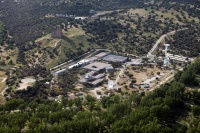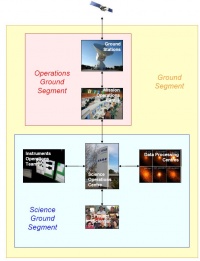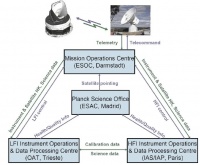Ground Segment and Operations
Contents
Geographical distribution of the Planck Ground Segment[edit]
The Planck Ground Segment consists of four geographically distributed centres:
The Mission Operations Centre[edit]
The mission operations centre (MOC), located at ESA’s operations centre in Darmstadt (Germany), is responsible for all aspects of flight control and of the health and safety of the Planck satellite, including both instruments. It plans and executes all necessary satellite activities, including instrument commanding requests by the instrument operations centres.
MOC communicates with the satellite using ESA’s 35-m antenna located in New Norcia (Australia), or that in Cebreros (Spain), over a daily 3-h period, during which it uplinks a scheduled activity timeline which is autonomously executed by the satellite, and downlinks the science and housekeeping (HK) data acquired by the satellite during the past 24 h. The downlinked data are transferred from the antenna to the MOC over a period of typically 8 h; at MOC they are put onto a data server from where they are retrieved by the two Data Processing Centres.
The Planck Science Office[edit]
The Planck Science Office (PSO) is located at ESA’s European Space Astronomy Centre in Villanueva de la Cañada surroundings (Madrid, Spain).
Its main responsibilities include:
- Coordinating scientific operations of the Planck instruments;
- Designing, planning and executing the Planck observation strategy;
- Providing MOC with a detailed pointing plan with a periodicity of about one month;
- Creating and updating the specifications of the Planck Legacy Archive developed by the Science Archives Team at ESAC;
- Testing and operating the PLA.
The LFI instrument operations and data-processing centre[edit]
The LFI instrument operations and data processing centre, located at the Osservatorio Astronomico di Trieste (Italy), is responsible for the operation of the LFI instrument, and the processing of the data acquired by LFI into the final scientific products of the mission.
The HFI instrument operations and data-processing centre[edit]
The HFI instrument operations and data processing centres, located respectively at the Institut d’Astrophysique Spatiale in Orsay (France) and at the Institut d’Astrophysique de Paris (France), are similarly responsible for the operation of the HFI instrument, and (with several other institutes in France and the UK) for the processing of the data acquired by HFI into the final scientific products of the mission.
The data flow in the Planck Ground Segment[edit]
The PSO sends the Pre-Programmed Pointing Lists (PPL) to the MOC. The Flight Dynamics team at ESOC adapts them into Augmented Pre-Programmed Pointing Lists (APPL) taking into account ground station scheduling, Operational Day (OD) boundaries and other issues.
MOC sends pointing and instrument commands to the spacecraft, and receives the house-keeping telemetry and science data through the ground stations (for Planck, mostly the New Norcia and Cebreros ones).
Science data is then transferred to both Data Processing Centres (DPC) which process the data and send quality reports to PSO.
Science products (timelines, maps, etc) are exchanged between DPCs in order to help calibration and other scientific issues.
More information about the Planck Ground Segment may be found in #tauber2010a.
Contingencies[edit]
The main unplanned events included the following:
- Very minor deviations from the scanning law include occasional (on the average about once every two months) under-performance of the 1-N thrusters used for regular manoeuvres, which implied the corresponding pointings were not at the intended locations. These deviations had typical amplitudes of 30 arcsec, and have no significant impact on the coverage map.
- The thruster heaters were unintentionally turned off between 31 August and 16 September 2009 (the so-called “catbed” event).
- An operator error in the upload of the on-board command timeline led to an interruption of the normal sequence of manoeuvres and therefore to Planck pointing to the same location on the sky for a period of 29 h between 20 and 21 November 2009 (“the day Planck stood still”). Observations of the nominal scanning pattern resumed on 22 November, and on 23 November a recovery operation was applied to survey the previously missed area. During the recovery period the duration of pointing was decreased to allow the nominal law to be caught up with. As a side effect, the RF transmitter was left on for longer than 24 h, which had a significant thermal impact on the warm part of the satellite.
- As planned, the RF transmitter was initially turned on and off every day in synchrony with the daily visibility window, in order to reduce potential interference by the transmitter on the scientific data. The induced daily temperature variation had a measurable effect throughout the satellite. An important effect was on the temperature of the 4He-JT cooler compressors, which caused variations of the levels of the interference lines that they induce on the bolometer data (Planck HFI Core Team 2011a). Therefore the RF transmitter was left permanently on starting from 25 January 2010 (257 days after launch), which made a noticeable improvement on the daily temperature variations.
- During the coverage period, the operational star tracker switched autonomously to the redundant unit on two occasions (11 January 2010 and 26 February 2010); the nominal star tracker was restored a short period later (3.37 and 12.75 h, respectively) by manual power-cycling. Although the science data taken during this period have normal quality, they have not been used because the redundant star tracker’s performance is not fully characterised.
For more information, see #planck2011-1-1.
References[edit]
<biblio force=false>
</biblio>
[ESA's] Mission Operation Center [Darmstadt, Germany]
European Space Agency
House Keeping
Planck Science Office
Planck Legacy Archive
(Planck) Low Frequency Instrument
(Planck) High Frequency Instrument
Pre-programmed Pointing List
European Space Operations Centre (Darmstadt)
Augmented Preprogrammed Pointing List
Operation Day definition is geometric visibility driven as it runs from the start of a DTCP (satellite Acquisition Of Signal) to the start of the next DTCP. Given the different ground stations and spacecraft will takes which station for how long, the OD duration varies but it is basically once a day.
Data Processing Center



